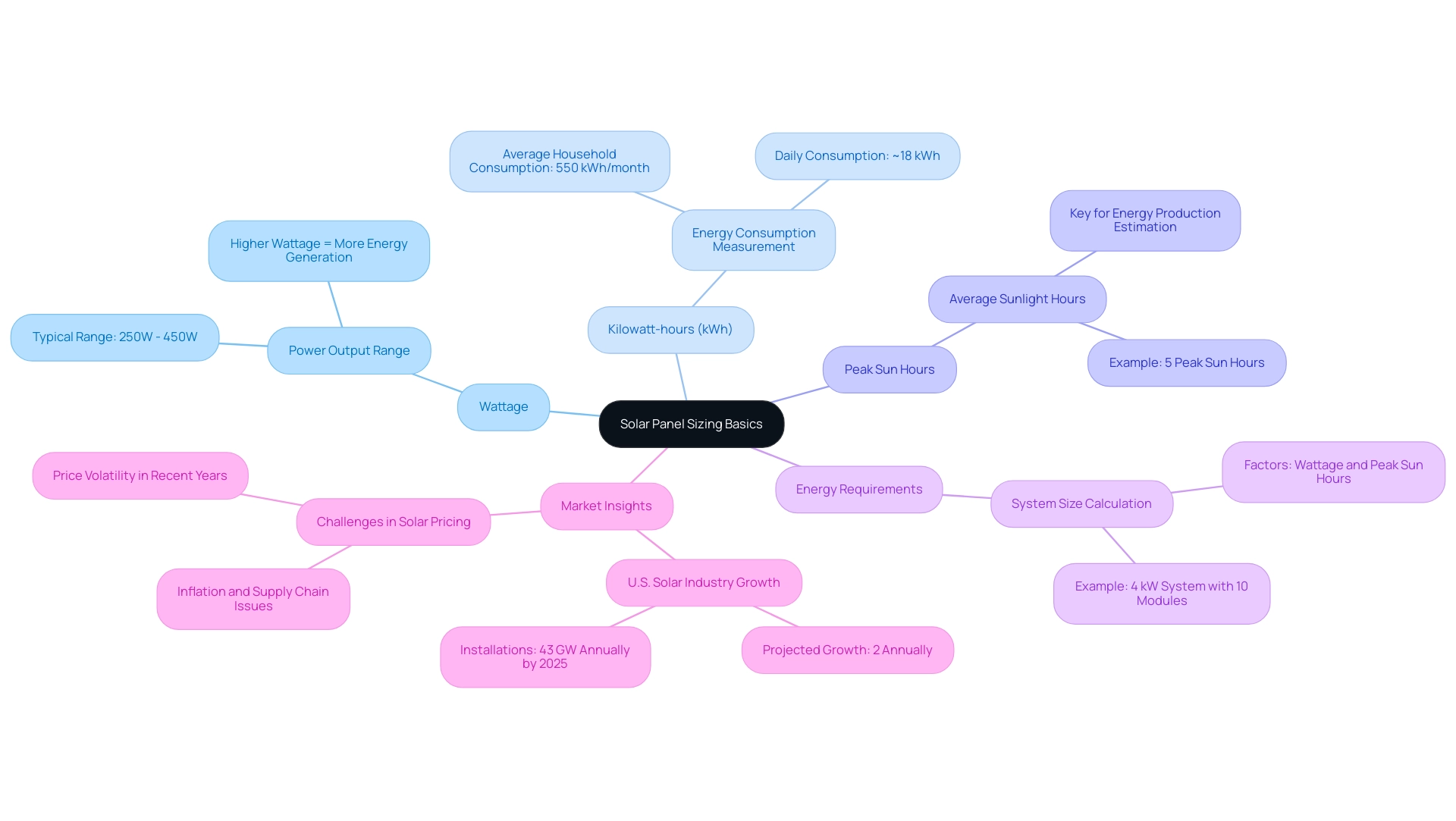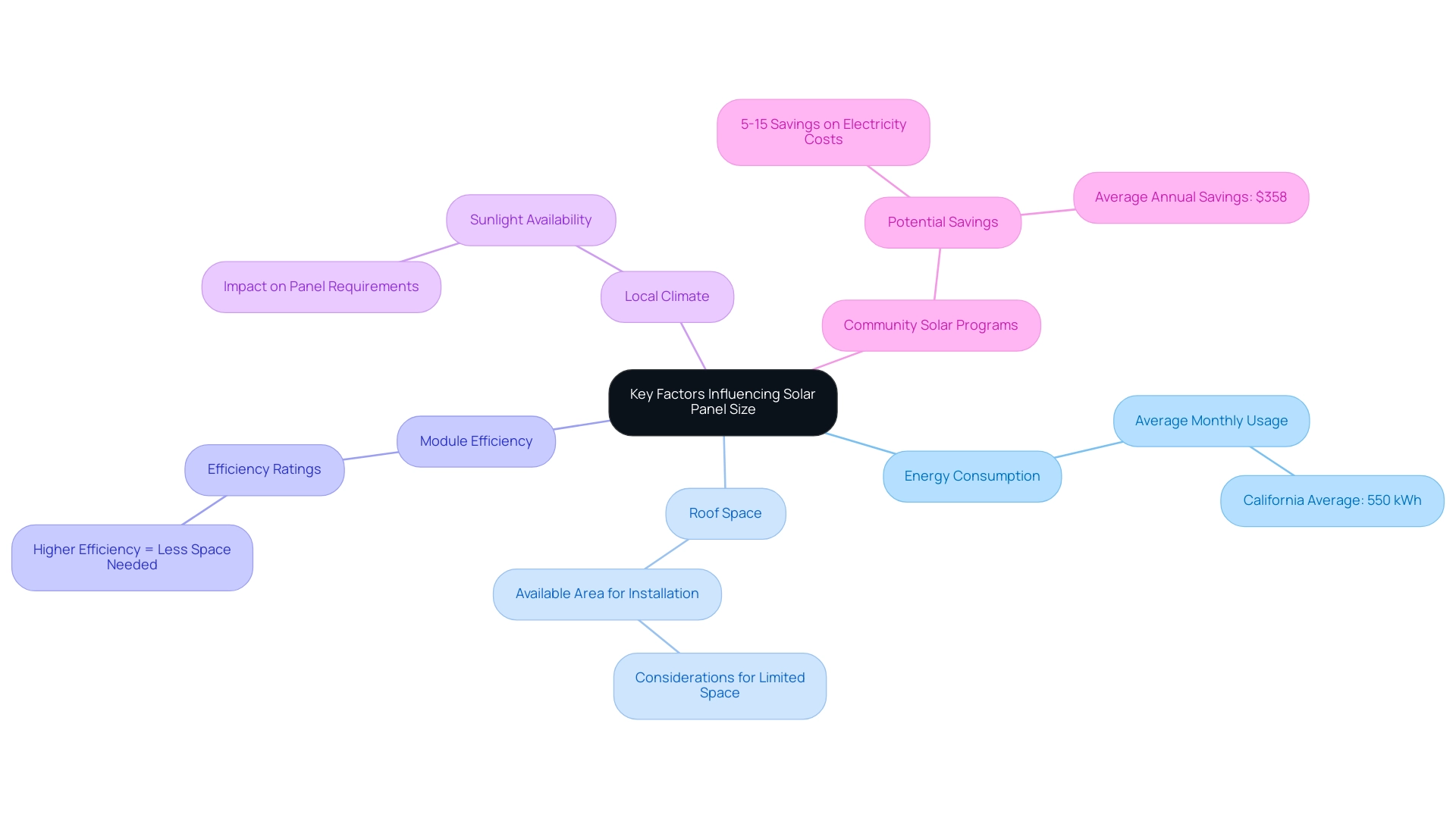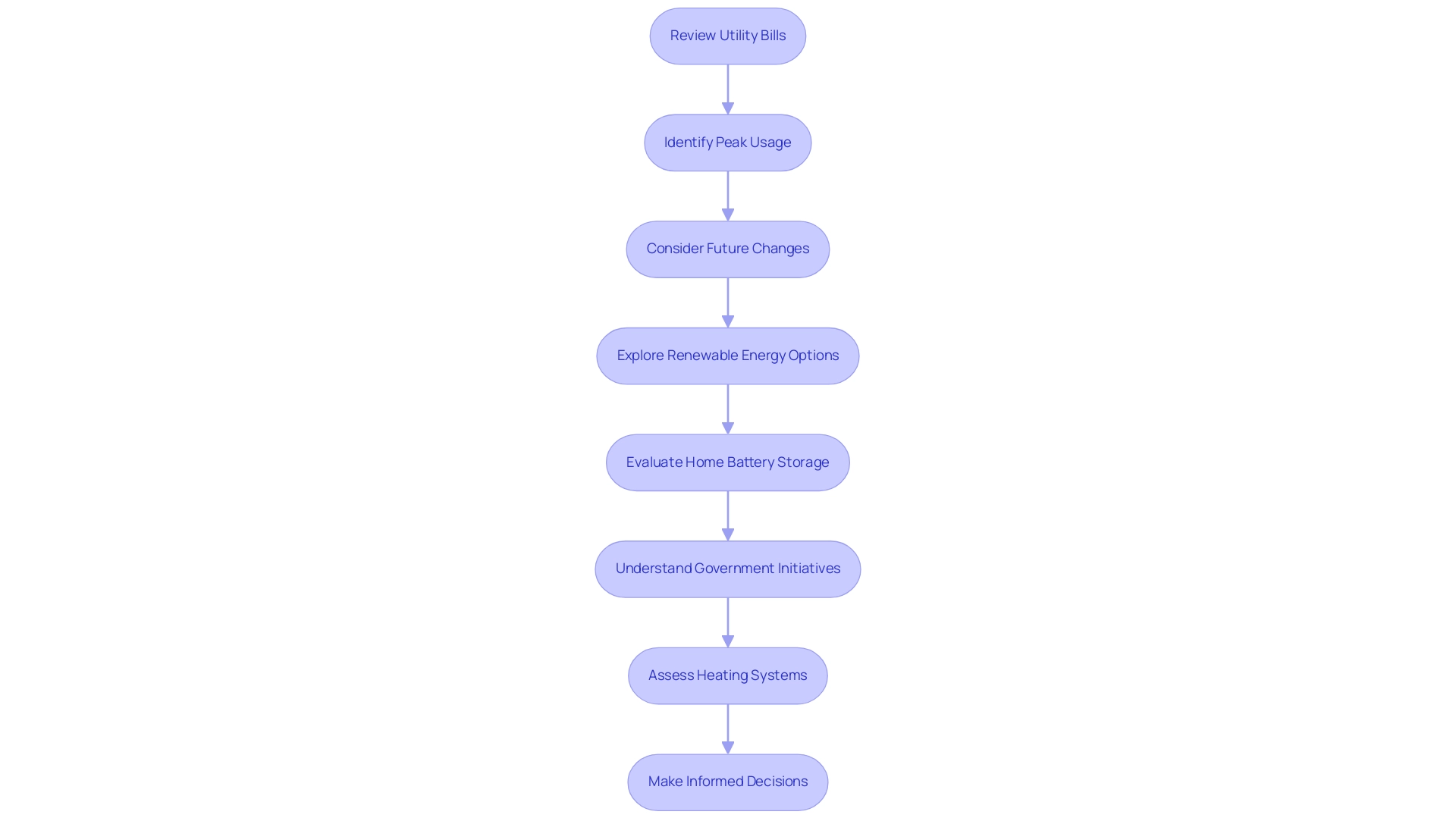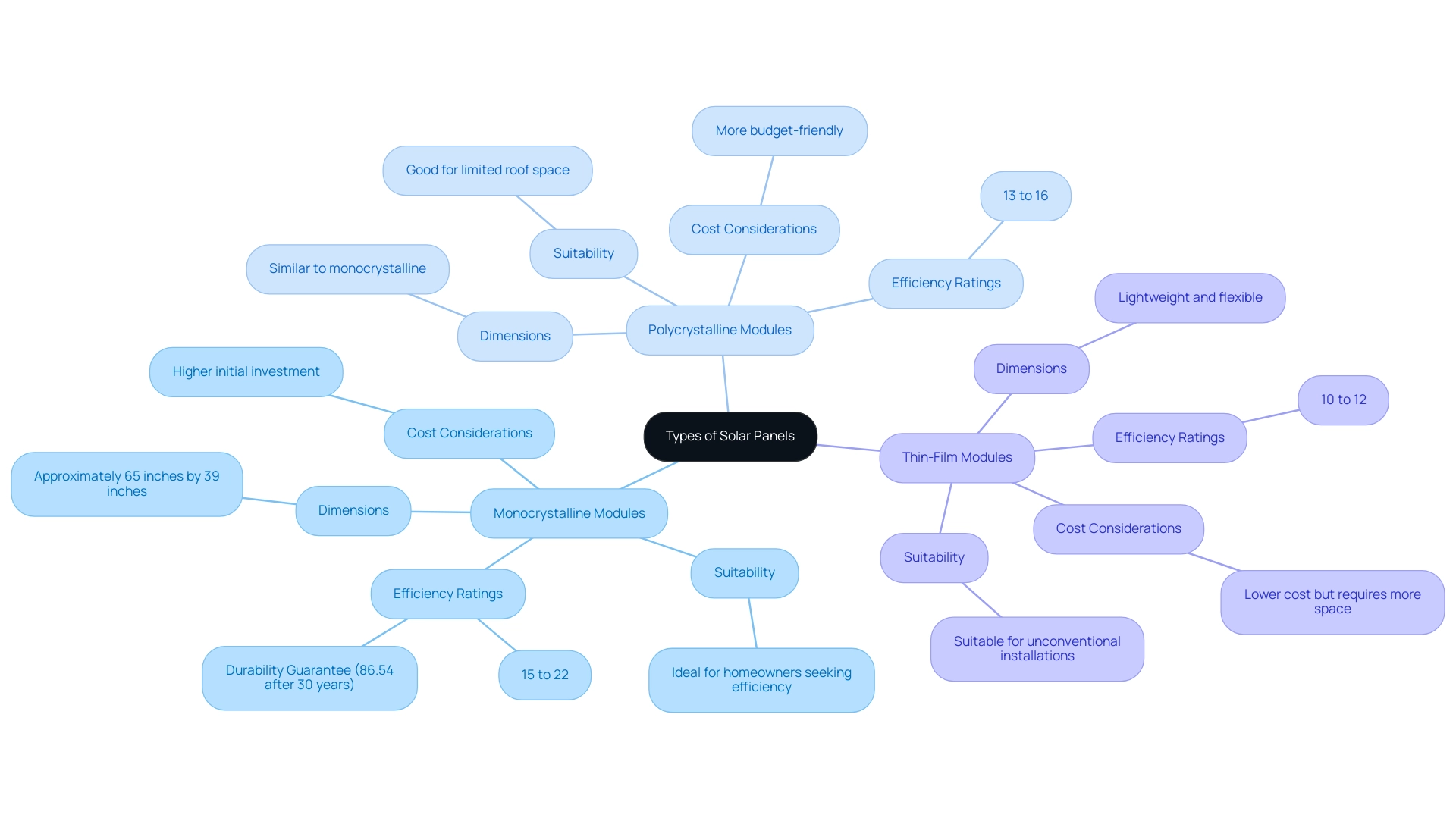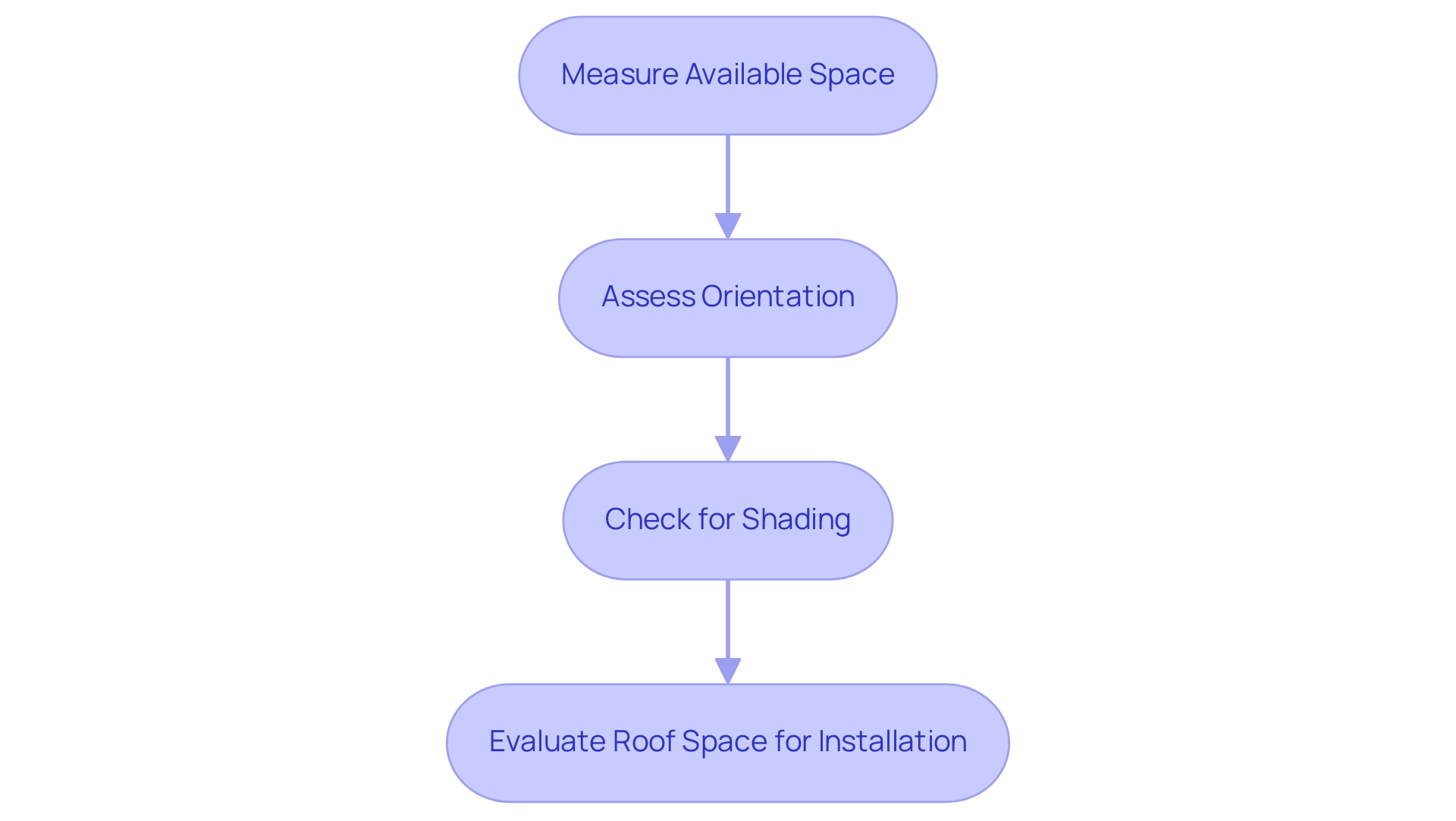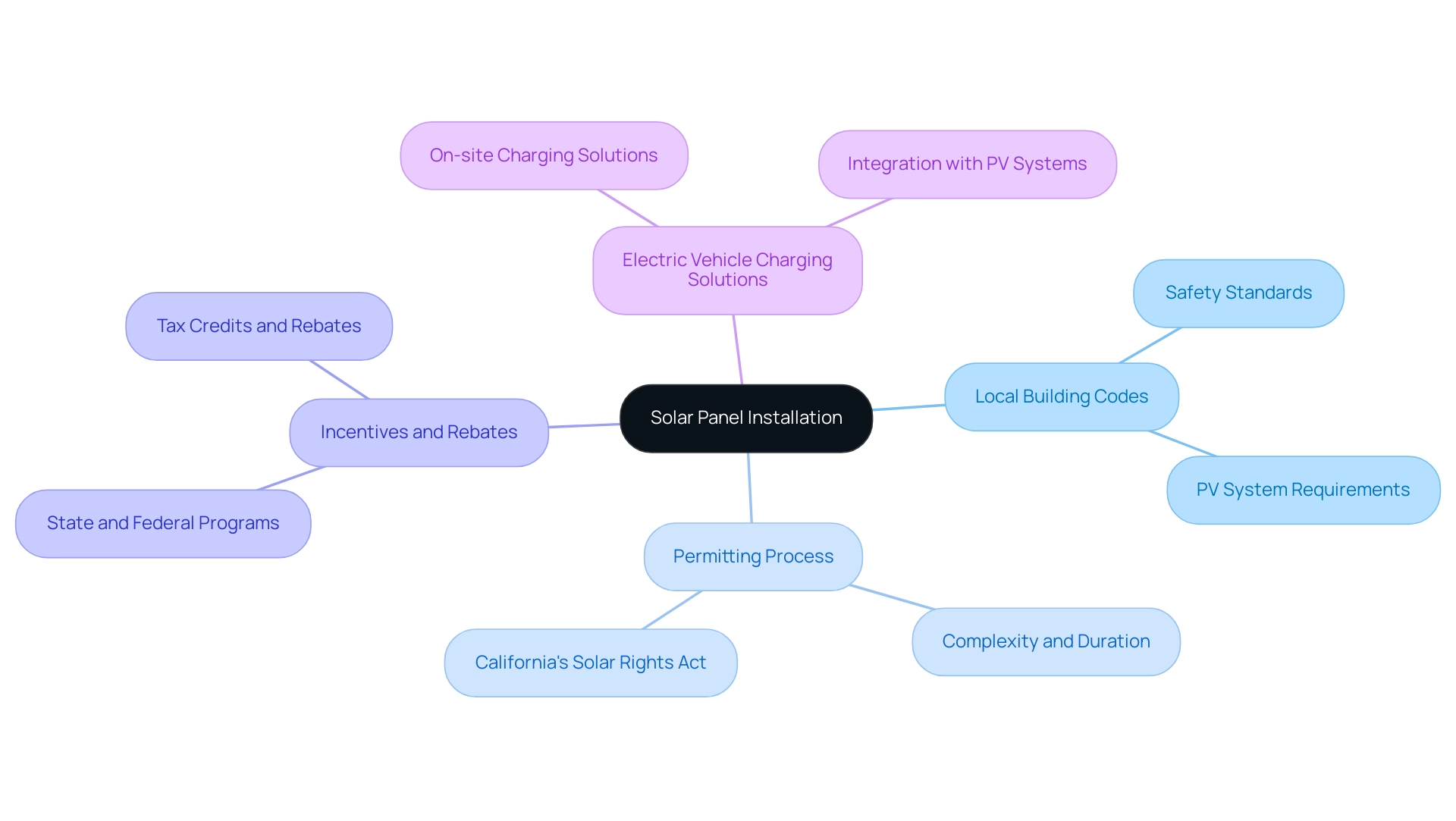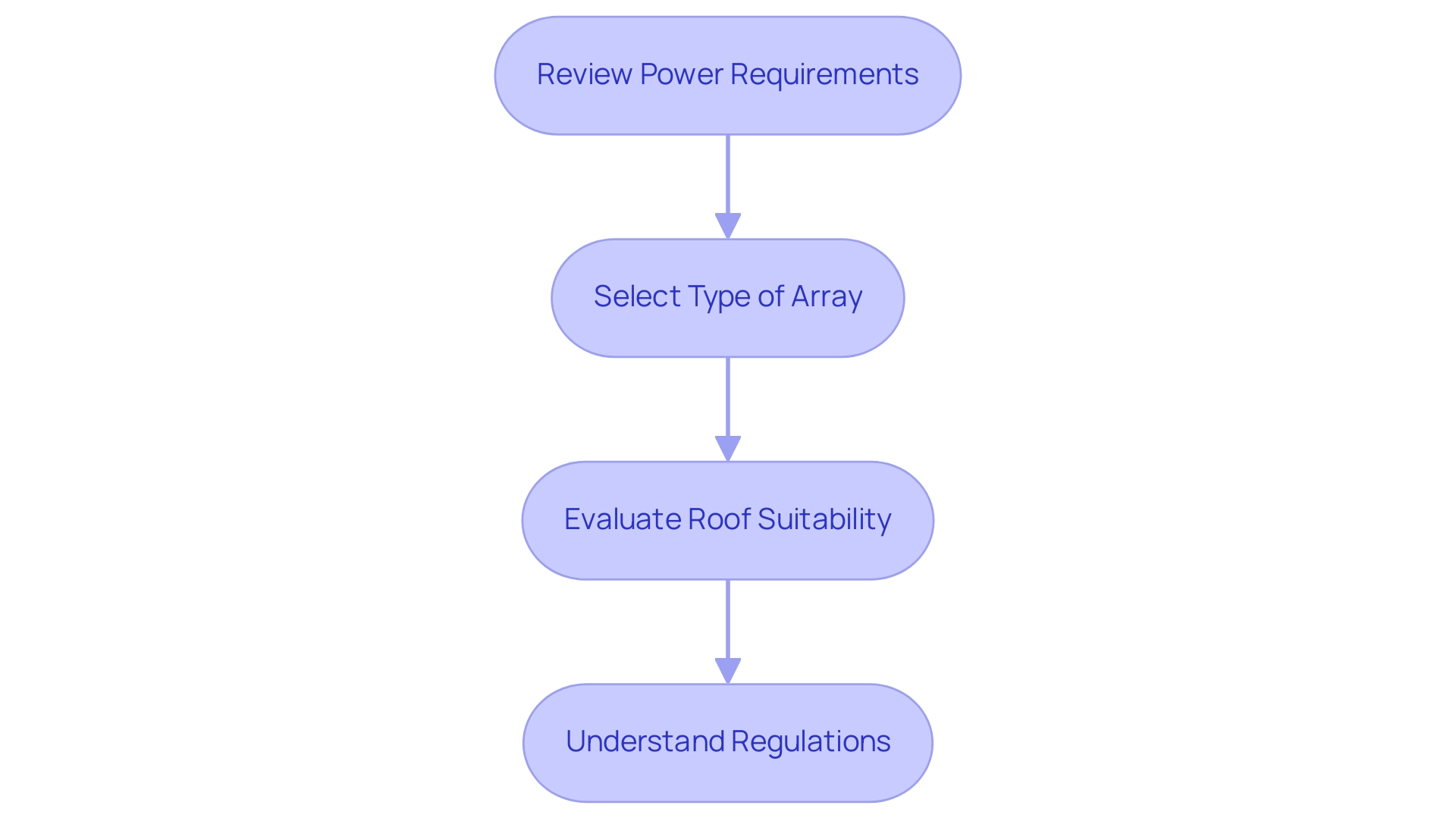Overview
Are you feeling overwhelmed by rising energy bills? You’re not alone. Many homeowners share this concern, and it’s completely understandable. To find a sustainable solution, consider sizing solar panels for your home. Start by evaluating your energy consumption, available roof space, and local sunlight conditions. This thoughtful assessment will help you determine the right number and type of panels needed to meet your unique needs.
Understanding key concepts like wattage, kilowatt-hours, and peak sun hours is crucial in this journey. These factors directly influence the efficiency and effectiveness of your solar energy system, ensuring it is tailored to your household’s requirements. Embracing solar energy not only helps alleviate financial stress but also paves the way towards energy independence.
Together, we can navigate this process. Let’s work towards a brighter, more sustainable future for your home. If you have questions or need guidance, please reach out. We’re here to support you every step of the way.
Introduction
In an age where sustainability is paramount, we understand that many homeowners are concerned about rising energy bills and the impact of their choices on the environment. This comprehensive guide is designed to help you navigate the intricacies of solar panel sizing, ensuring you can harness the power of renewable energy effectively.
We delve into essential concepts such as:
- Wattage
- Kilowatt-hours
- Peak sun hours
Empowering you to make informed decisions that optimize your solar installations. For environmentally conscious residents in Long Beach, the transition to clean energy is not just a trend; it’s a meaningful step towards energy independence.
As the solar industry continues to grow, it’s common to feel overwhelmed by the complexities of panel selection, energy requirements, and local regulations. However, with the right guidance, you can maximize both your financial savings and environmental benefits. Together, we can explore valuable insights into effectively sizing a solar system that aligns with your personal energy consumption and sustainability goals.
Let’s work towards a brighter, greener future.
Understanding Solar Panel Sizing Basics
The journey of sizing solar panels for your home is an important step towards sustainable living, particularly for environmentally conscious homeowners in Long Beach who are looking to reduce their energy bills. Understanding how many and which photovoltaic modules you need to meet your household’s power requirements is essential. Let’s explore some key concepts together:
- Wattage: This refers to the power output of a photovoltaic device, typically ranging from 250W to 450W for residential installations. Choosing higher wattage panels means more energy generation, leading to a more efficient system.
- Kilowatt-hours (kWh): This unit measures energy consumption over time and is vital for determining the energy production your photovoltaic system needs. Knowing your household’s kWh consumption is crucial for accurately sizing your solar panels.
- Peak Sun Hours: This term describes the average number of hours per day when sunlight is strong enough to effectively generate electricity. Understanding peak sun hours is key to estimating how much energy your panels can produce.
Grasping these concepts is fundamental, as they lay the groundwork for sizing solar panels for home systems. In California, the average household consumes about 550 kWh per month, translating to roughly 18 kWh daily. By considering this usage, you can calculate how many energy collectors you need, factoring in the wattage of the units and the peak sunlight hours available in your area.
For instance, if your home uses 18 kWh daily and enjoys an average of 5 peak sun hours, you would need a system of approximately 4 kW, achievable with 10 modules rated at 400W each.
Looking ahead, the U.S. renewable energy sector is projected to grow by 2% annually by 2025, with installations expected to reach at least 43 GW each year. This trend highlights the increasing importance of understanding how to size solar panels for your home. Furthermore, recent challenges related to pricing due to inflation and supply chain issues underscore the need for careful planning when investing in renewable energy technology.
While we’ve seen significant price drops over the past two decades, the renewable energy market has experienced fluctuations in recent years, impacting your options for sizing solar panels. Additionally, with over 9.4 GW of photovoltaic cells imported, current market dynamics affect the availability and pricing of modules. By familiarizing yourself with these essential terms and ideas, you can make informed decisions about your energy systems, ensuring they meet your energy needs sustainably while considering alternatives like Tesla home chargers and battery storage solutions.
At Powercore Electric, we offer a range of services to assist homeowners in Long Beach with energy array setup and sizing solar panels for homes, ensuring you can effectively harness renewable energy. We also encourage you to explore government programs and incentives that can help offset the costs of energy installations, making this a more accessible option for eco-conscious individuals. Together, we can work towards a greener future.
Key Factors Influencing Solar Panel Size
Several critical factors influence the size of solar panels needed for your home, and we understand that navigating these choices can feel overwhelming:
-
Energy Consumption: Start by assessing your average monthly electricity usage, typically measured in kilowatt-hours (kWh), as indicated on your utility bills. In California, homeowners average around 550 kWh per month, serving as a baseline for determining the power output your panel system must achieve.
-
Roof Space: The available area on your roof for solar installations significantly determines how many units can be installed. If your roof area is restricted, you might need to consider more effective modules that can produce greater power per square foot.
-
Module Efficiency: Solar modules vary in effectiveness; certain designs convert a greater portion of sunlight into usable power. More efficient units generate greater power in reduced space, making them ideal for homes with limited roof area.
-
Local Climate: The amount of sunlight your area receives is essential in sizing your photovoltaic system. Homes in sunnier regions can often meet their power needs with fewer panels compared to those in areas with less sunlight.
Understanding these elements is crucial for sizing solar panels to efficiently meet your unique power needs. Additionally, with rising electricity rates and increasing average monthly bills, it’s vital to consider how solar energy can provide a sustainable solution. In California, factors contributing to high electric costs include rising electricity rates, increased power consumption, and inefficient appliances, making renewable options even more appealing.
Moreover, community solar programs in California offer an alternative for those unable to install panels on their property, potentially saving 5-15% on electricity costs. This approach enables broader participation in the clean power transition, making it a viable option for many homeowners.
By assessing these factors, you can make informed choices that align with your resource requirements and contribute to a sustainable future. Powercore Electric’s dedicated team of specialists ensures top-notch setups and maintenance, giving you confidence that your energy system will be customized to your unique needs. With a commitment to exceptional service and a strong community focus, Powercore Electric stands out as a trusted partner in your journey towards sustainable power solutions.
As one satisfied customer noted, “Ryan and his team were great. They were quick, effective, and adhered to the timeline for our energy setup. I have referred Powercore to some friends, and they were also happy with their service. I’d definitely recommend Ryan and Powercore Electric.” This reflects the high level of customer satisfaction that Powercore Electric consistently delivers.
Furthermore, under the 200% regulation, homeowners can optimize their photovoltaic systems to ensure they produce sufficient power to meet their needs, further enhancing the advantages of renewable solutions.
Assessing Your Home’s Energy Requirements
To effectively evaluate your home’s power needs for panel installation, it’s essential to follow these steps that truly matter:
-
Review Utility Bills: Start by examining your monthly electricity usage in kilowatt-hours (kWh) over the past year. This will help you calculate your average power usage, which is crucial for sizing solar panels for your home. With the average yearly electricity usage per household in California being roughly 6,600 kWh, having an accurate assessment of your power needs is vital for maximizing your renewable investment.
Identify Peak Usage: Take a closer look at your utility bills to pinpoint periods of peak power consumption. Many California households experience increased consumption during the summer months due to air conditioning and cooling needs. By understanding these patterns, you can size solar panels effectively to meet higher energy demands during peak times. -
Consider Future Changes: It’s common to feel uncertain about future power usage. Anticipate any changes that may occur, such as adding new appliances, electric vehicles, or even plans for home expansions. By considering these potential increases, you can ensure your system is suitably sized, which is essential when sizing solar panels for your home to meet your evolving power requirements. This thorough evaluation will provide clear insight into how much power your system must generate, empowering you to make informed choices regarding your installation.
Additionally, homeowners in California have the opportunity to significantly lower electricity expenses by generating their own renewable electricity and utilizing home batteries for storage. Powercore Electric is dedicated to community engagement and assistance, ensuring that clients receive tailored support throughout their renewable journey, establishing them as a reliable ally in achieving power independence.
Moreover, exploring alternatives like Tesla home chargers and understanding government initiatives can enrich your renewable energy experience. Evaluating the advantages and disadvantages of shingle systems can lead to more informed decisions. Embracing both active and passive heating systems contributes to long-term sustainability and energy efficiency integration. Together, we can work towards a brighter, more sustainable future.
Exploring Different Types of Solar Panels and Their Dimensions
When considering photovoltaic systems for your home, we understand that grappling with energy bills can be overwhelming. It’s essential to explore the different types available, each offering unique dimensions and efficiency ratings that can help ease your concerns:
-
Monocrystalline Modules: Known for their high efficiency, typically ranging from 15% to 22%, these modules are crafted from the purest silicon. Measuring approximately 65 inches by 39 inches, their rounded edges and dark color not only enhance aesthetic appeal but also contribute to their popularity among homeowners seeking effective solar solutions. Notably, monocrystalline modules are recognized for their longevity and efficiency. Manufacturers like Powercore Electric assure that their products will produce at least 86.54% of their rated output after 30 years. This reliability not only lowers utility expenses but also enhances your energy autonomy.
-
Polycrystalline Modules: While slightly less efficient than their monocrystalline counterparts, with efficiency ratings between 13% and 16%, polycrystalline modules are often more budget-friendly. Their dimensions are similar to monocrystalline units, making them a practical choice for those with limited roof space. These modules still play a vital role in sustainability efforts by providing a dependable power source.
-
Thin-Film Modules: Lightweight and flexible, these structures are suitable for unconventional installations. However, they are the least efficient, with ratings of 10% to 12%, necessitating more space for effective power generation. Despite their lower efficiency, they can still contribute to reducing greenhouse gas emissions when integrated into a broader energy strategy.
As we look towards 2025, advancements in technology continue to shape module design. Many manufacturers are transitioning from lower-cost P-type cells to more efficient N-type cells. For instance, Powercore Electric is committed to enhancing power output and sustainability, aligning with initiatives like the Biden-Harris administration’s Solar for All program, which aims to ensure equitable access to renewable resources.
Real-world examples illustrate the performance of these modules. Monocrystalline units are celebrated for their durability and efficiency, with manufacturers like Powercore Electric guaranteeing that their units will generate at least 86.54% of their rated output after 30 years. On the other hand, polycrystalline modules, while slightly less effective, still provide a reliable option for homeowners striving to balance cost and functionality.
As former Editor Andrew Blok noted, understanding the evolving power landscape is crucial for making informed choices regarding photovoltaic module selection. Ultimately, sizing solar panels for your home should align with your roof area, budget, and power needs. Together, we can ensure you select the most suitable option for your home while contributing to a more sustainable future.
Calculating the Number of Solar Panels Needed
To accurately determine the number of solar panels required for your home, it’s essential to focus on sizing solar panels by following these important steps.
-
Determine Daily Energy Needs: Start by calculating your monthly electricity usage in kilowatt-hours (kWh). Divide this figure by 30 to establish your average daily power consumption.
For instance, if your monthly usage is 900 kWh, your daily power requirements would be 30 kWh.
-
Calculate Required kW Output: Next, assess the average peak sun hours your location receives. In California, homeowners can typically expect around 5 to 6 peak sun hours per day.
Divide your daily power requirements by the number of peak sun hours to find the necessary kilowatt (kW) output. Using the previous example, if you have 5 peak sun hours, the calculation would be:
- Daily kW output needed = 30 kWh / 5 hours = 6 kW.
-
Divide by Output: Finally, determine the wattage of the photovoltaic modules you intend to install.
For example, if you choose 300W panels, divide the required kW output by the panel wattage:
- Number of panels needed = 6,000W / 300W = 20 panels.
This straightforward calculation helps ensure that you can effectively meet your energy needs with solar power. Furthermore, performing a home efficiency audit can help pinpoint areas of waste and recommend improvements to boost effectiveness, ultimately reducing your utility bills. As noted, a home efficiency audit is crucial for recognizing potential improvements in consumption.
In the context of California’s landscape, it’s important to consider that net imports for 2022 were 83,960 GWh, accounting for 29.2 percent of total system electric generation. This statistic highlights the significance of sunlight solutions in decreasing dependence on imported power. Furthermore, examining the best battery options for power storage can enhance your system’s efficiency, enabling you to store surplus power produced during peak sunlight periods for use during the evening or overcast days.
This is especially advantageous for eco-conscious homeowners aiming to optimize their investment in renewable resources.
As an example, consider the Viejas Tribe of Kumeyaay Indians, who received $31 million from the California Energy Commission in 2022 for a long-duration storage system. This initiative not only offers renewable backup power but also enhances grid reliability during emergencies, underscoring the importance of efficient power management in residential environments.
By adhering to these steps and utilizing expert guidance, you can confidently engage in sizing solar panels for your home to attain independence and sustainability. As Hannah Bastawrose, a mechanical engineering graduate, highlights, comprehending your daily power requirements and sunlight output assessments is crucial for making educated choices regarding photovoltaic setups. Moreover, consider government programs that may provide incentives for renewable power adoption, further enhancing the economic advantages of your investment.
Evaluating Roof Space and Orientation for Solar Panel Installation
When assessing your roof for photovoltaic system setup, we understand that you may have concerns about your energy bills. To enhance efficiency and power output, consider the following steps:
-
Measure Available Space: Start by determining the overall surface of your roof appropriate for energy collectors. Be sure to account for obstructions such as chimneys, vents, and skylights, which can limit the usable space. Grasping the 200% guideline can also assist you in optimizing your system setup, enabling enhanced power production and possible savings.
-
Assess Orientation: The positioning of your roof plays a crucial role in power generation. South-facing roofs typically gather the most sunlight during the day, making them perfect for panel installation. However, east and west-facing roofs can also generate significant power, especially if they receive unobstructed sunlight during peak hours. Comprehending the three typical metrics of sunlight exposure—global horizontal, direct normal, and diffuse horizontal irradiance—can further clarify how roof orientation affects power generation.
-
Check for Shading: Evaluate your surroundings for any potential shading from trees, buildings, or other structures. Even slight shading can drastically decrease the effectiveness of photovoltaic systems, resulting in considerable power losses. Research shows that shading can lower energy collector output by as much as 80%, highlighting the significance of an unobstructed sunlight pathway. It’s common to feel concerned about nearby trees and structures; consider their long-term growth when assessing shading.
-
Evaluate Roof Space for Installation: Utilize tools like the reV model, which allows you to assess renewable power potential by analyzing geospatial data. This model enables you to identify the best positioning of photovoltaic systems based on particular roof traits and regional circumstances, aiding in informed choices concerning power generation. Furthermore, investigating alternatives such as solar shingle tiles can offer visual advantages while enhancing efficiency. Solar panel shingles not only integrate smoothly with your roof but also provide a dual purpose of protection and power generation, making them a compelling choice for environmentally aware homeowners.
By carefully assessing these factors, you can make informed decisions about sizing solar panels for your home and their potential power output, ultimately improving your home’s efficiency and sustainability. At Powercore Electric, we take pride in being locally owned and community-focused, providing personalized service and support as you move towards sustainable practices. Together, we can explore the tangible benefits of investing in renewable energy. Case studies have shown that homeowners who have implemented energy systems under the 200% rule have experienced significant reductions in their energy bills and increased property value, showcasing the positive impact of your investment.
Understanding Local Regulations and Incentives for Solar Installation
Before embarking on the journey of solar panel installation with Powercore Electric, we understand that you may have concerns about energy bills and the overall process. Familiarizing yourself with several key factors can significantly influence both your experience and the benefits you receive:
-
Local Building Codes: Each locality has specific regulations that govern solar installations. It’s essential to consult with your local government to understand any unique requirements or restrictions that may apply to your project. These codes ensure that setups meet safety and efficiency standards, which can vary significantly across different regions. For instance, the Building Energy Efficiency Standards encourage the use of renewable energy in newly built low-rise residential structures by requiring photovoltaic (PV) systems and solar-ready criteria.
-
Permitting Process: We know that obtaining the necessary permits can feel daunting. The complexity and duration of this process can differ widely depending on your location. In California, for example, the average time for solar setup permitting can range from a few days to several weeks, influenced by local regulations and the completeness of your application. As Maxwell Harris, a Quality Assurance Electrician, notes, “California’s statewide Solar Rights Act helps streamline the process by limiting the local government’s ability to impose overly burdensome requirements.” Understanding this process can assist you in planning your setup timeline effectively.
-
Incentives and Rebates: Exploring available state and federal incentives is vital for maximizing your financial benefits. Programs such as tax credits and rebates can significantly lower the overall cost of installation. Keeping updated on these opportunities can have a meaningful impact on your investment in renewable sources. It’s also important to note that California’s photovoltaic regulation does not require storage batteries, offering homeowners flexibility in their power storage choices.
-
Electric Vehicle Charging Solutions: With the rising popularity of electric vehicles, on-site charging solutions are becoming essential for eco-conscious homeowners. Incorporating Tesla home chargers with your photovoltaic panel system can enhance your power efficiency and sustainability, allowing you to fuel your vehicle with clean resources.
By understanding local construction regulations, the approval procedure, and available incentives, you can simplify your setup experience and enhance the financial benefits of transitioning to renewable power. Additionally, considering both active and passive heating systems can further improve your home’s energy efficiency and contribute to long-term sustainability. Together, we can work towards a greener future. Powercore Electric is here to assist you with expert installation services and customized energy solutions tailored to your needs.
Finalizing Your Solar Panel Sizing Decisions
To finalize your solar panel sizing decisions, we understand that it’s essential to consider the following steps:
-
Review Power Requirements: Begin by assessing your current and anticipated power consumption. This includes evaluating your monthly electricity usage and factoring in any future changes, such as the addition of electric vehicles or home expansions. Understanding your energy needs is crucial when sizing solar panels for your home, especially since utility companies in California can impose flat monthly charges of up to $24.15, even for those with minimal usage. This can significantly impact your overall savings.
-
Select Type of Array: Choose the type of array that fits your budget and available space. Options range from monocrystalline modules, known for their efficiency and sleek design, to polycrystalline units, which are generally more affordable but may require more space. Consulting with experts at Powercore Electric can provide insights into which type best suits your specific situation, ensuring you make an informed choice.
-
Evaluate Roof Suitability: Assess whether your roof can support the number of panels required for your power needs. Factors to consider include the roof’s orientation, angle, and structural integrity. A well-designed roof maximizes sunlight exposure, boosting power generation. Engaging with professionals from Powercore Electric can help determine the best layout for optimal performance, leveraging their local expertise and commitment to quality craftsmanship.
-
Understand Regulations: Familiarize yourself with local regulations and incentives that may influence your setup. California homeowners benefit from numerous state incentives designed to encourage the use of renewable power. Staying informed about these can significantly affect your overall investment and savings. Powercore Electric is dedicated to guiding you through these opportunities, ensuring you maximize your financial benefits while contributing to a sustainable future.
By carefully adhering to these steps for sizing solar panels for your home, you can confidently move forward with your panel setup, ensuring it effectively meets your energy needs while contributing to a sustainable future. As A. Salusky shared, “I had a really wonderful experience with installing energy panels at my home.” The Powercore Electric team was responsive and kept me informed each step of the way.
I am proud to share that my utility bill is at zero most months, and I am saving money due to the setup.
Customer feedback is invaluable when selecting energy solutions, as it reflects the real-world impact of our services. Additionally, it’s important to be aware of the current market dynamics. For example, Ross Williams, owner of HES Solar, reported a dramatic decline in sales due to recent pricing decisions, emphasizing the significance of understanding the market landscape when considering energy installations.
Contact Powercore Electric today for your complimentary, customized estimate and find out how together we can attain independence, financial savings, and sustainability with our advanced solar solutions. Our commitment to sustainable energy solutions not only benefits your wallet but also contributes positively to the environment.
Conclusion
Understanding solar panel sizing is essential for homeowners concerned about rising energy bills and seeking sustainable energy solutions. By grasping key concepts such as wattage, kilowatt-hours, and peak sun hours, you can effectively determine your energy needs and the appropriate solar system size. Factors like energy consumption, roof space, panel efficiency, and local climate significantly influence this decision-making process.
Moreover, being informed about local regulations and available incentives can enhance both the financial and practical aspects of solar installation. With the right planning and guidance, you can optimize your solar investments, ensuring you harness the full potential of renewable energy while contributing to a greener future.
As the shift toward clean energy continues to gain momentum, taking these steps not only leads to personal financial savings but also plays a vital role in the broader transition to sustainable living. Engaging with local experts and utilizing available resources will empower you in Long Beach to make informed choices that align with your energy consumption and sustainability goals. Together, we can embark on this journey towards energy independence, starting with the right knowledge and support.



